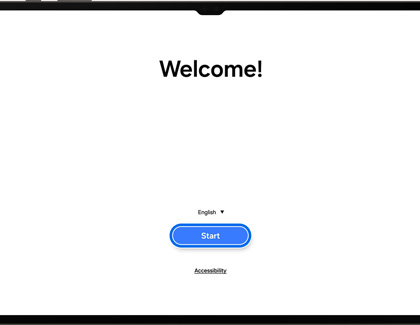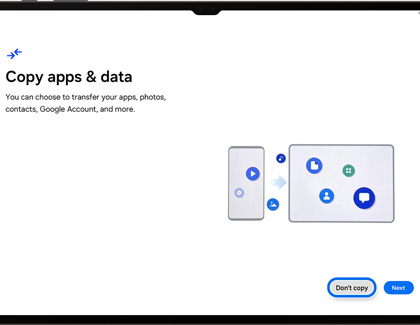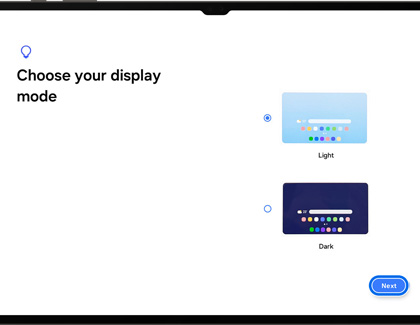Set up your Samsung tablet

Set up your Samsung tablet
Turning on the tablet for the first time

The steps for setting up a tablet may vary depending on whether it has an LTE connection or is Wi-Fi only. You can refer to your carrier for specific setup instructions if these steps don't totally match up, or for help with SIM card setup.
- If you have an LTE or 5G tablet, you may need to insert your physical SIM card first. If you'll be using one, now is also a great time to insert a MicroSD card. If your carrier supports eSIM, you'll be prompted to set it up as part of the initial setup, or you can set up your eSIM later.
- Charge the tablet. Plug the included USB-C cable into the charger, and then plug the charger into an outlet. Plug the other end into the tablet's USB-C port. Make sure you are using the correct charger and cable.
- Press and hold the Side button until the tablet turns on. Once it fully boots up, you will be greeted by the Welcome screen, where you can select the primary language. Tap Start to continue.

- Take a few moments to review the Terms and Conditions, Privacy Policy, and diagnostic data, and then tap Agree to All. Tap Agree to continue.
- If you'd like to transfer settings, accounts, apps, and other data from another device, tap either Galaxy or Android device, or iPhone or iPad, depending on what you'll be transferring from. You can follow the on-screen instructions to transfer your data, or refer to our Smart Switch page.
- Choose a Wi-Fi network. You will need to connect to Wi-Fi to get the most out of your tablet. The tablet will scan for nearby networks, so select your network when it appears. If your network is hidden, tap Add network and enter it manually. Enter the password to connect.
- The steps may differ from here if you have an LTE or 5G tablet. If you are using an eSIM, follow the on-screen instructions. If you need to activate your eSIM or physical SIM, you should check with the carrier to ensure it is activated correctly. Otherwise, tap Skip.
- After your tablet is connected, it will take a few minutes to configure the settings that you just finished selecting. You'll have another opportunity to transfer apps and data from a previous device. (Please see the Ways to transfer your content section for details.) If you do not want to transfer any data from a previous device, tap Don't copy. From here, you will be prompted to sign into or create a Google account. A Google account will give you access to the Play Store and many other features that will help you use your tablet.

- You'll be prompted to add a lock screen to your device. A lock screen will keep unauthorized users from accessing your data. Choose your lock type, and follow the instructions to add it to your tablet. If you choose a biometric lock, like fingerprints or face recognition, you'll be prompted to add a standard lock as well.
- Now you can sign in to, or create a Samsung account. With a Samsung account, you'll be able download apps, sync with other Galaxy devices, and even locate your tablet if it goes missing.
- Finally, you'll need to choose whether you'd like to use Light mode or Dark mode. Tap either option to see how it will appear, and then tap Next.

- You've finished setting up your tablet!
Ways to transfer your content
Before anything else, choose which transfer method you'd like to use with Smart Switch. Review the following information about wireless and wired transfers, transfers via iCloud, and transfers using an external storage device.
- Wireless transfer: A wireless transfer is a quick way to move content from one device to another. You can keep your devices plugged in as well, so there’s no need to worry about your battery draining during the transfer. Make sure you have Smart Switch installed on both devices before you begin.
- Transfer with a USB cable: For a more secure and reliable transfer, you can connect your devices using a USB cable. However, you will not be able to connect a charger, so make sure everything is fully charged before starting.
- Transfer via iCloud: If you are transferring from an iPhone, you can access your stored iCloud data with Smart Switch. Check your iPhone first to make sure all of your important data has been saved to iCloud, just in case there is something missing.
- Transfer with an external device: Using an external storage device is another option for transferring your content. You can use a microSD card or USB OTG flash drive to back up your data on one device and then move it to another device. You will need to insert the microSD card or flash drive into your old device to create a backup of your data before transferring it.
Content that can and cannot be transferred with Smart Switch
Data transferable from Android:
- Personal content: Contacts, S Planner, Messages, Memo, Call logs, Clock, and Internet.
- App data: Images, Music (DRM free content only), Videos (DRM free content only), Documents, Story Album, and Applications.
- Settings, etc: Email, Wallpaper, Lock screen, Radio, and Preferences.
Data transferable from iOS via iCloud:
- Personal content: Contacts, Schedule, Notes, Call history, and Bookmarks.
- App data: Photos, Videos (DRM free content only), Documents, Recommended apps, and Voice Memos.
- Settings, etc: Wi-Fi and Alarms.
Data transferable from a USB cable:
- Personal content: Contacts, Schedule, Messages, Notes, Call history, and Bookmarks.
- App data: Photos, Music (DRM free content only), Videos (DRM free content only), Documents, Recommended apps, and Voice Memos.
- Settings, etc: Wi-Fi and Alarms.
Smart Switch settings
You may be concerned about keeping your content safe while it’s being transferred. Thankfully, Smart Switch has a few security options you can use to protect your data. You can enable these options to set authentication and password requirements for transferring data.
Navigate to and open Smart Switch, and then tap More options (the three vertical dots). Tap Settings, and then tap your desired security option.

- Enhance transfer security: To protect your data, an authentication code must be entered when transferring files.
- External storage encryption: Select your preferred option when restoring backup files from microSD cards and USB storage devices.
- Secure Folder encryption: Select your preferred option when restoring backup files from Secure Folder.
You can also tap About Smart Switch to review the app version, Terms of Service, and open source license information. Regularly updating Smart Switch to the latest version will ensure the app is receiving the most recent security patches.
Troubleshooting Smart Switch
Do more with your tablet
- Sync gallery with OneDrive: Set your Gallery to automatically sync with OneDrive, so that your files can be accessed any time.
- Connect with Samsung Health: Sync your tablet to Samsung Health-compatible devices to help you stay on track with your fitness needs.
- Adjust display settings: Adjust everything from the size of the font, the color settings, white balance, and the size of everything on the screen.
- Multitask on your tablet: Split screen view lets you open two apps on your tablet and use them simultaneously.
- Change the wallpaper: You can customize the Galaxy themes, Samsung wallpapers, and icons on your device to fit your tastes.
- Take a screenshot: The method for capturing a screenshot will vary for each device, but is an easy and convenient process for saving images.
- Bixby: Bixby is a virtual assistant that makes it easier to use your tablet and focus on what matters most.
- Second screen: If you have a Windows 10 or later PC, you can utilize the tablet as a second screen to increase productivity.
- DeX: You can use your tablet just like a PC with DeX mode.
- Samsung Kids Mode: Samsung Kids Mode lets your child safely use their Galaxy device. You can set up parental controls, monitor their browsing history, and control the apps they have access to.



Contact Samsung Support






